Stompbox 101, For Real: Learning to Build Pedals the Classy Way at Roberto-Venn
I could make one of these things, is how the thought usually takes form. Indeed, it proves a common mantra among stompbox enthusiasts. Once one becomes an aficionado of effects pedals, suddenly the urge strikes to not just acquire a new stomp, but… build one oneself.
That’s about where I was in the journey when I discovered the esteemed Roberto-Venn School of Luthiery was offering a class in pedal making. Roberto-Venn’s reputation was well known to me as perhaps the premier guitar-making school in the United States. Legends like Jason Lollar of Lollar Pickups, Rob Timmons of Arcane Pickups, and Joe Naylor of Reverend Guitars are all Roberto-Venn alumni, and artists spanning Paul McCartney to Paul Simon play axes crafted by R-V grads.
It’s a pilgrimage I can’t resist. The mission: over the course of a weekend, build a Fuzz Face – perhaps the most iconic of the original fuzz pedal circuits. In particular, we were to build the silicon circuit version whose slashing tones proved beloved of Jimi Hendrix, David Gilmour, Eric Johnson, and Stooges’ six-string guru Ron Asheton alike. Taking an actual pedal-making class versus wading through innumerable YouTube tutorials of varying quality greatly appealed to me. For one, as a technical novice, I don’t even know my way around the proper tools: hand me a soldering iron, and I’m more likely to burn a house down – let along create an electronic device that emits sound. Secondly, I figured Roberto-Venn’s course wouldn’t just produce a pedal, but demystify them – imparting a greater holistic understanding of just how the magic of effects pedals comes into being.

“We start at the basics of electronics – ‘this is a resistor,’ ‘this is Ohm’s law,” notes the class’ instructor, Jim Kramer, who designed Roberto-Venn’s entire electronics curriculum covering pedals and tube amps. “Basically, we’ll end up covering five semesters in one day!”
Before that, however, a Fuzz Face was to be built. Kramer – a wry former Marine with a serious engineering background, as well as an avid guitarist and double-bass player – proves an ideal professor to learn all things fuzz from. “If anything, I’m more into how figuring out how to create and refine effects from an electronic and maker standpoint than I am their actual music application,” he admits.
From a pedagogical perspective, however, Kramer understands their sonic allure. In his textbook How to Build a Distortion Pedal – an essential tome that’s worth the price of the course alone – Kramer aptly breaks down the appeal of the fuzz. “When you think Big Muff, think of Pink Floyd guitarist David Gilmour’s guitar break on ‘Comfortably Numb.’ Metallica’s debut album Kill ‘Em All features lots of Rat-distorted electric guitar. You are going to learn how to build a replica of the famous Dallas-Arbiter Fuzz Face distortion pedal used by Jimi Hendrix. This was the pedal Jimi used on his iconic tune ‘Foxy Lady.’”
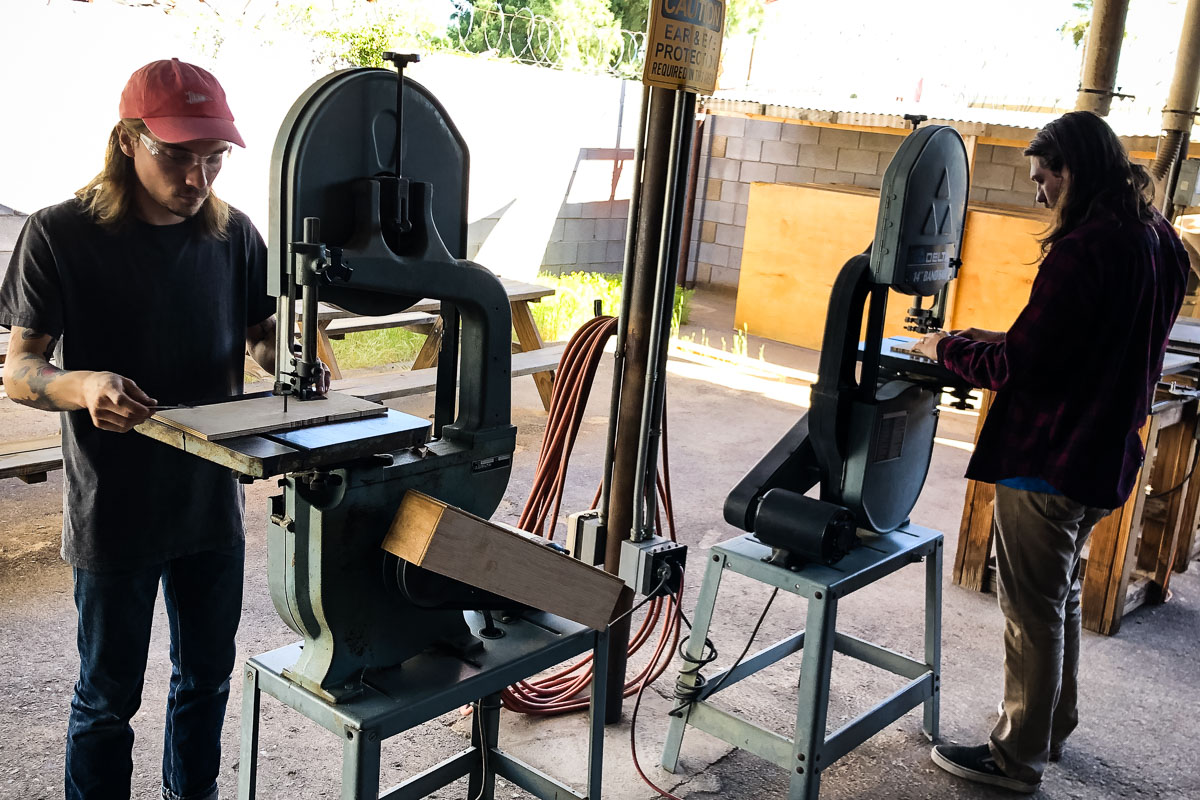
I’m no Hendrix, but as day one of the pedal class began, Kramer chose me to demonstrate the particular tonal alchemy of the Fuzz Face to the ten or so of my fellow classmates – about half drawn from Roberto-Venn’s five-month, full-time guitar making program, and the rest drawn from across the country (one had come in from Boston just to take the weekend class) to the school’s urban Phoenix, Arizona location. Kramer chose me seemingly at random, but I was no stranger to the Fuzz Face’s pleasures. I’d actually become previously acquainted with the absurdly storied stomp from owning actually one of the rarest Fuzz Faces ever made.
While that particular model had a germanium-based circuit, it behaved basically the same way all Fuzz Faces do. In particular, I’d learned from pedal-player genius Joe Gore the most effective technique to manipulate this kind of fuzz circuit: dime the controls on the pedal itself – then use the guitar’s volume knob to dial in the amount of grit, grime, and gain so desired. The Fuzz Face is actually incredibly dynamic in terms of touch sensitivity and its interaction with guitar pickups. By employing this volume-knob method, turning down on the guitar increases the highs and mid-tone quotient, allowing for a more naturalistic attack and overtones; turning up, meanwhile, transforms the guitar’s output into something simultaneously raw yet deliciously smooth and liquid, with a violin-like, almost vocal quality in its compression. Most of my fellow students hadn’t had much experience playing Fuzz Faces, and were dazzled by the possibilities I wreaked out of it via a Strat into a Fender Deluxe-style amp – from the sparkly, chiming overdrive it imparted to clean tones when dialed back, to the roar of fuzz that resulted at 10 when I launched into the totemic riff from “I Wanna Be Your Dog.” The resulting mass unison head nod from my classmates in response proved immensely satisfying – we were now on the path to hard-clipping distortion satori together.
Day one began by assembling the various parts of the Fuzz Face kit, which were to be assembled on a circuit board designed by Kramer specifically for its clarity of layout: “I didn’t design this for industrial production so much as to have it be very obvious where everything is supposed to go,” he explained. After explaining the color-coding of the resistors and a bit about the distinct even-order harmonics quality of the double-transistor Fuzz Face circuit, we were off to the races. After band-sawing apart the circuit boards, Roberto-Venn’s open-plan workroom turned oddly quiet considering the noise boxes being manufactured in it.
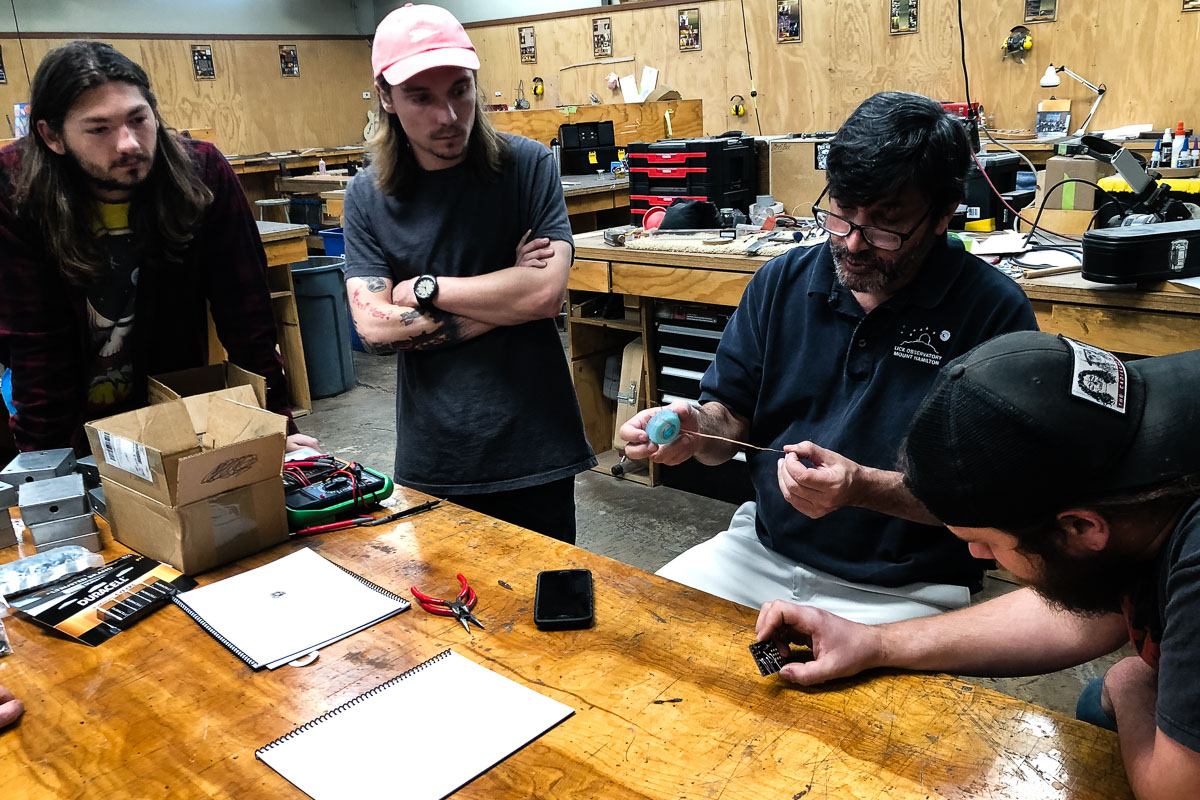
Pedal making requires intense concentration and orderly workflow. Even though the simple Fuzz Face circuit typically requires no more than eleven components, they are small: the screws, resistors, capacitors, and holes to be soldered tend towards the minute and very fine, and the order and layout proves anything but random.
In addition to being wildly knowledgeable, Kramer proves wildly amusing, describing the germanium-based Fuzz Face as “more mid-rangey, like Rob Zombie on steroids”; he decries the use of a buffer in front of a simple fuzz circuit like the Fuzz Face’s, noting “it leaves less paint on your palette.”
I, a soldering virgin, followed the advice of mentor Kramer: “When it comes to soldering, less is more. You only want to add enough solder to lock it in.” Thankfully, I turned out to be something of a solder savant. This is the stuff of real right-brain oriented, calm, creative problem solving. I quickly found a hypnotic, meditative rhythm in cleaning the tip of the soldering pen in the coils of a brass sponge, and then touching the tip of the solder wire to it for a fraction of a second until the cavity filled just enough molten metal to restrict the wire. I managed to only singe my flesh badly once! Meanwhile, Kramer marveled at how remarkably cleanly I’d rendered the connections on my board. It was utterly satisfying, especially as a novice, to have this aspect of pedal making demystified, and to gaze on a nice, relatively clean circuit board.
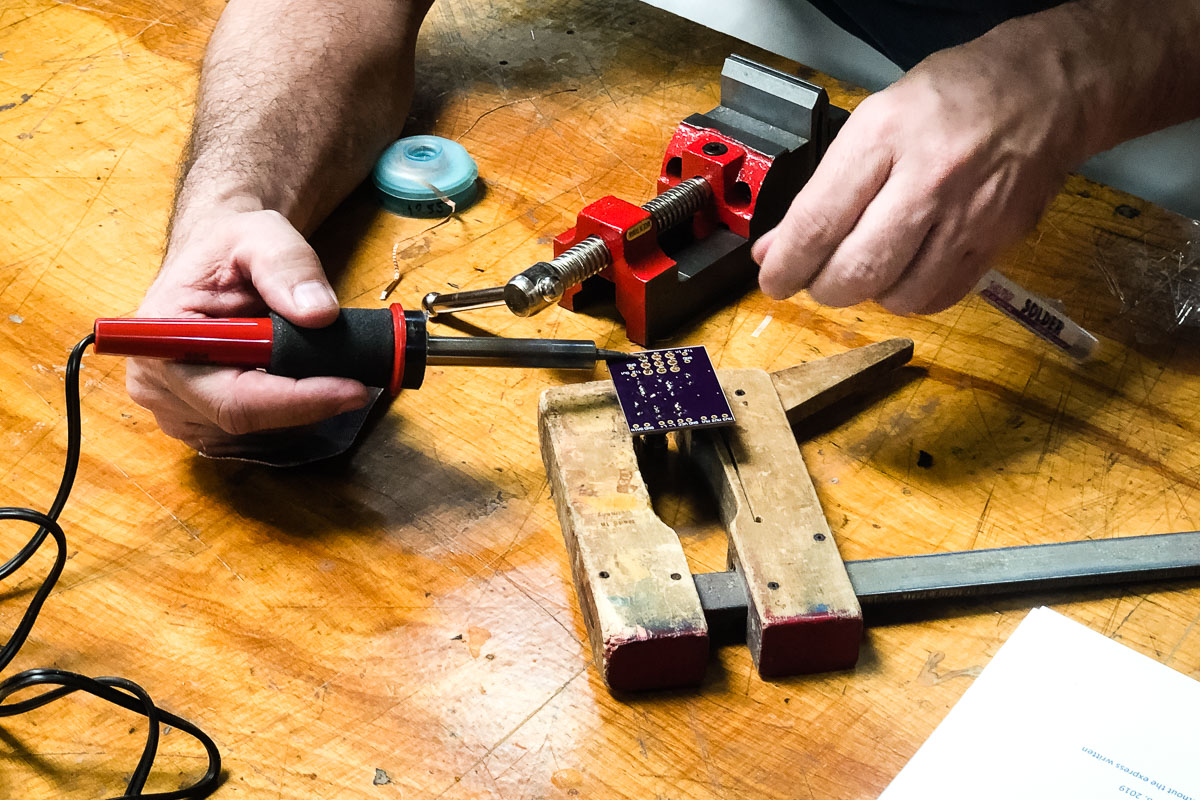
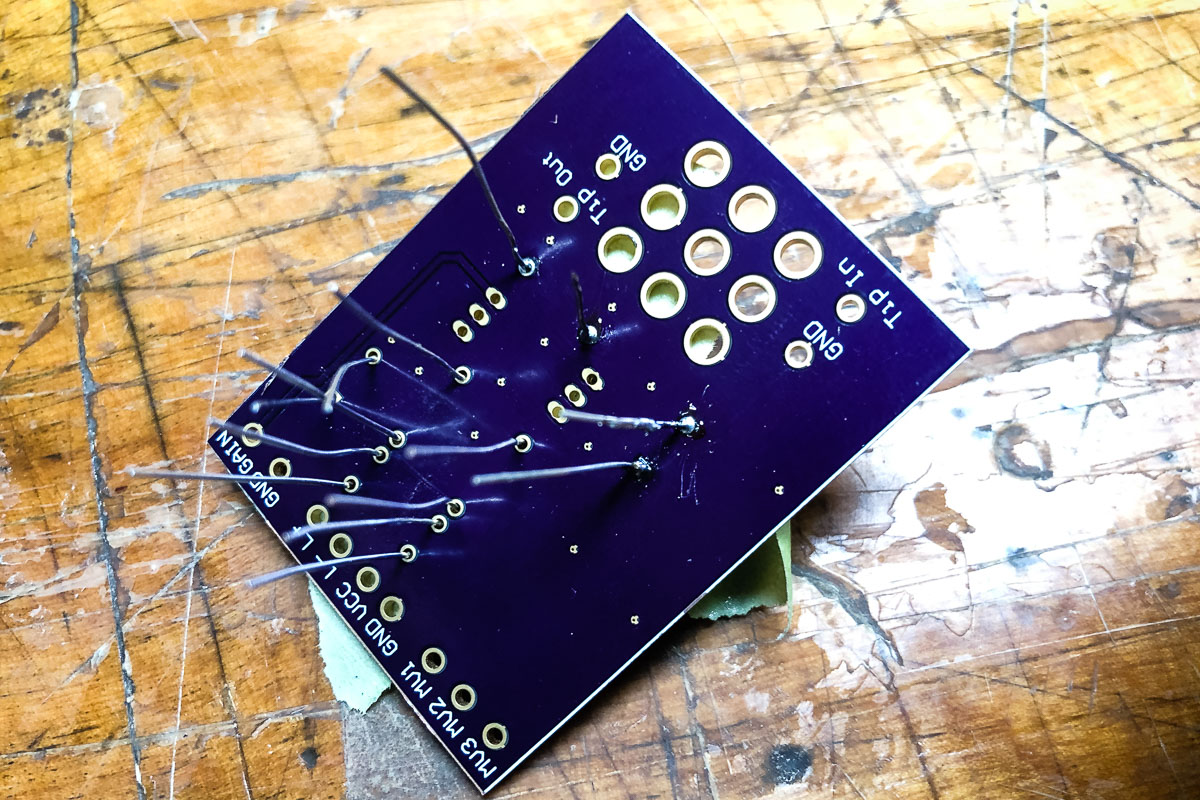
As appealing as a tidy circuit steadily built over a course of hours might be, it’s the sound it produces that thrills. As the group began to finish up their pedals, their minimal, logo-free, raw metal enclosures begin to reveal the fury unleashed once appended to willing amplifiers. “That’s the rock and roll signal – that bell-like sound is the essence of vintage, old-guy distortion,” Kramer marvels as Riley Kilian – a luthier grad of Roberto-Venn and virtuoso doom-metal guitarist from Syracuse, New York – rips plaster-removing riffage on his Jerry Cantrell G&L Rampage enhanced by a Fuzz Face he’d birthed from raw parts just minutes earlier. “Wow, I think I may have found my sound,” an inspired Kilian raves. “I’m going to go write some cool shit!”
Day two of Roberto-Venn’s pedal-making class proves less hands on, and more about the theory that drives not just the Fuzz Face, but all distortion/fuzz-based pedals. In addition to being wildly knowledgeable, Kramer proves wildly amusing, describing the germanium-based Fuzz Face as “more mid-rangey, like Rob Zombie on steroids”; he decries the use of a buffer in front of a simple fuzz circuit like the Fuzz Face’s, noting “it leaves less paint on your palette.” As poetic as Kramer may become in extolling the virtues of fuzz, he’s as rock solid on the physics and math that makes it possible. Polarity, voltage, impedance, heat dispersion, electromotive foce, the virtues of even and odd harmonics, hard-and-soft signal clipping, and how the Fuzz Face changes a sine wave to a pulse wave – Kramer covers it all with great patience.
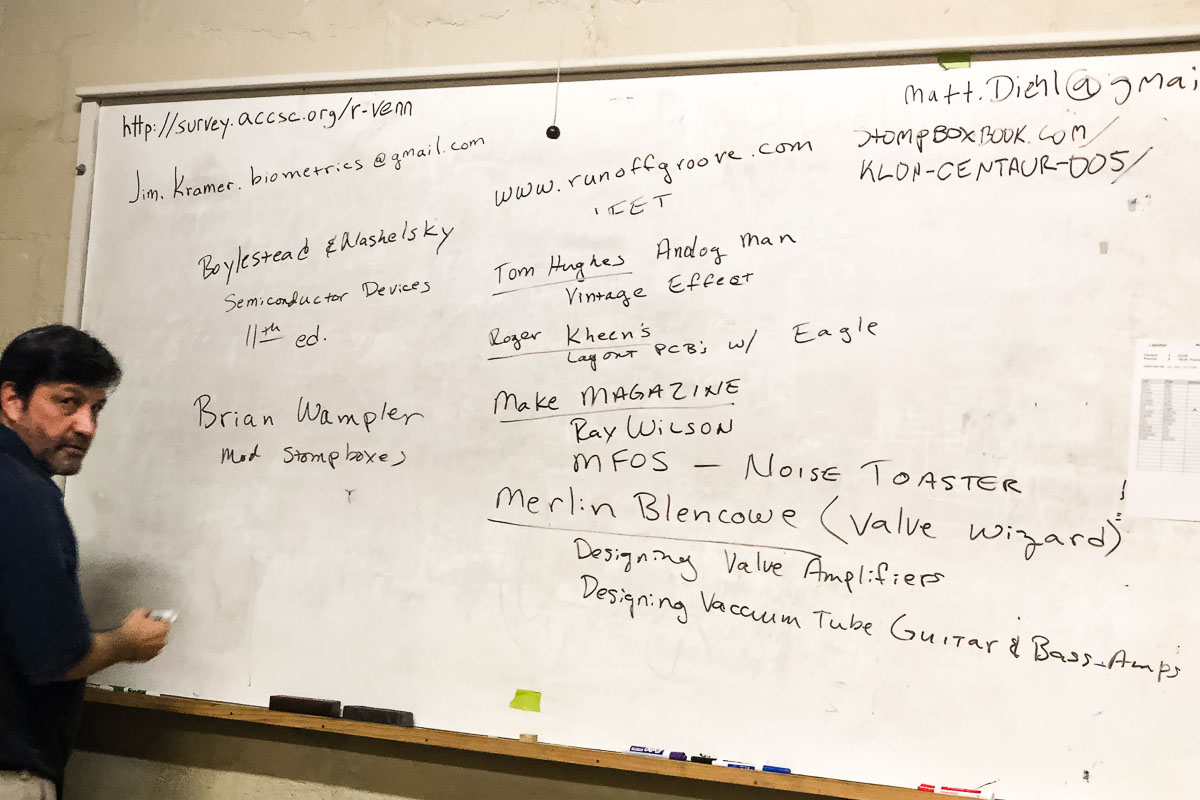
The latter is necessary considering the range of experience with such things in the room; while one student in the pedal class was a former senior Apple engineer, I have very little comprehension of the technical basis behind guitar pedals. Between Kramer’s provided textbook and his explanations, however, I was able to fill in a lot of gaps in my knowledge cribbed together from practical experience and reading too many Internet forums. What proved most insightful was Kramer breaking down the technical differences between a variety of different fuzz/distortion/overdrive-based pedals. Especially after having just acquired practical knowledge of what it takes to put a pedal together, Kramer’s technical explanations really resonated – not just on the Fuzz Face circuit, but also the Big Muff Pi, Tone Benders, ProCo Rat, Boss DS-1, Z. Vex Fuzz Factory, the ubiquitous Ibanez Tube Screamer, and the almighty Klon Centaur, and how they interact with amplifiers. What I’d learned from both listening and doing imparted new heft to what I thought I already knew about effects. Pedal technology seemed far less foreign as a result, as did the possibility of making another attempt at building a pedal myself.
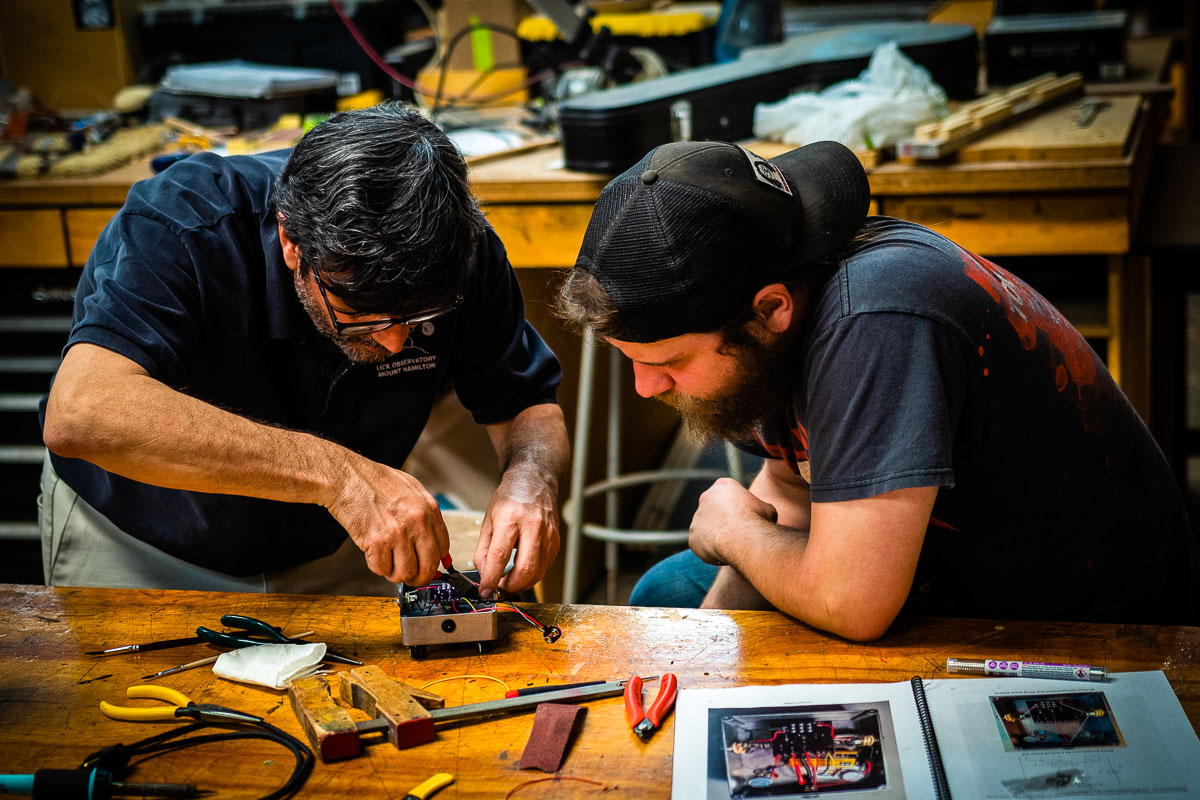
My favorite part of the class, however, was the troubleshooting that occurred when, by fluke, I discovered my pedal didn’t work. Despite my surprisingly elegant soldering technique that resulted in a very clean board – as well as checking with Kramer after each step of the process to make sure I’d completely them correctly – when finally wired up with a 9V battery, my Fuzz Face wasn’t producing much in the way of fuzz – or anything resembling sound. Gazing at my visually pristine if electronically uncooperative circuit board, Kramer wasn’t fazed. “This is part of the most important part of the process,” he noted. “I’m going to reflow all your joints just to make sure.”
Between my newfound knowledge and his longtime expertise, it didn’t take too much tinkering, however, for Kramer to get the pedal up and running, and sounding like a proper Fuzz Face. Along the way, he tidied up a few things, and biased out some noise, making it sound even better with just subtle refinements that clearly are born out of relentless experimentation, curiosity, and experience.
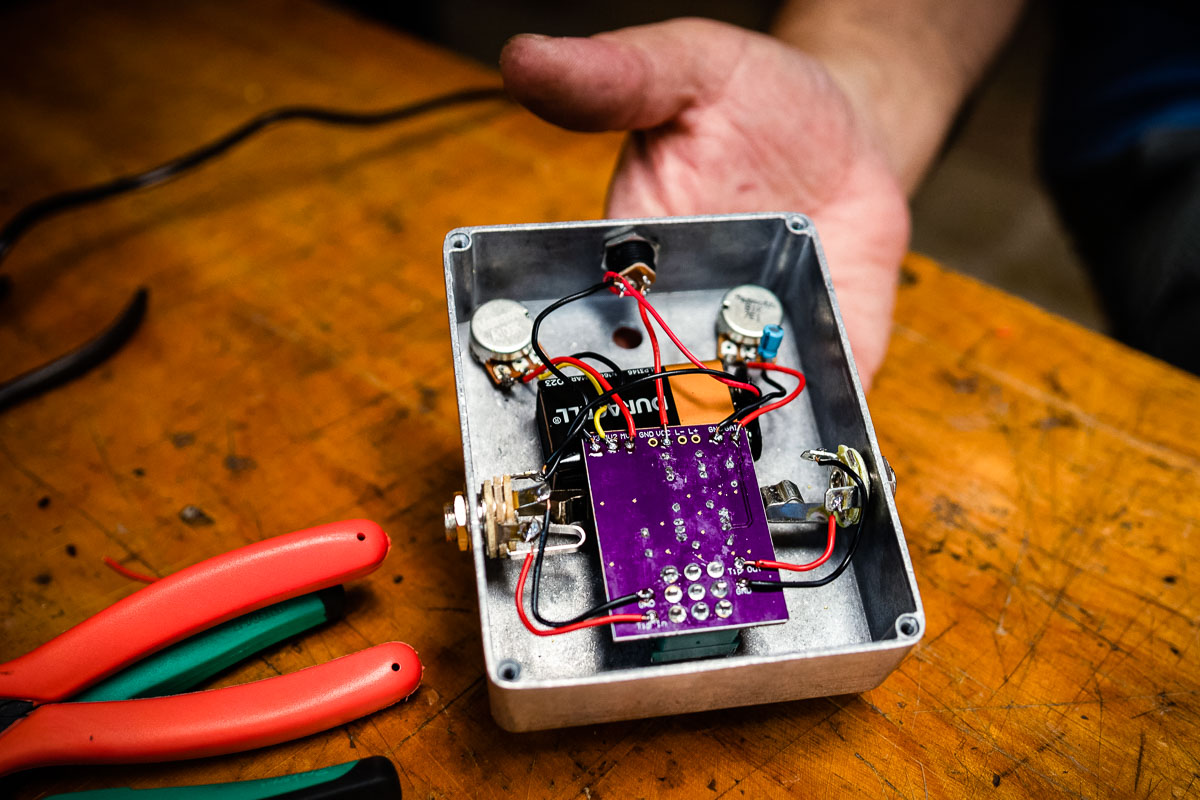
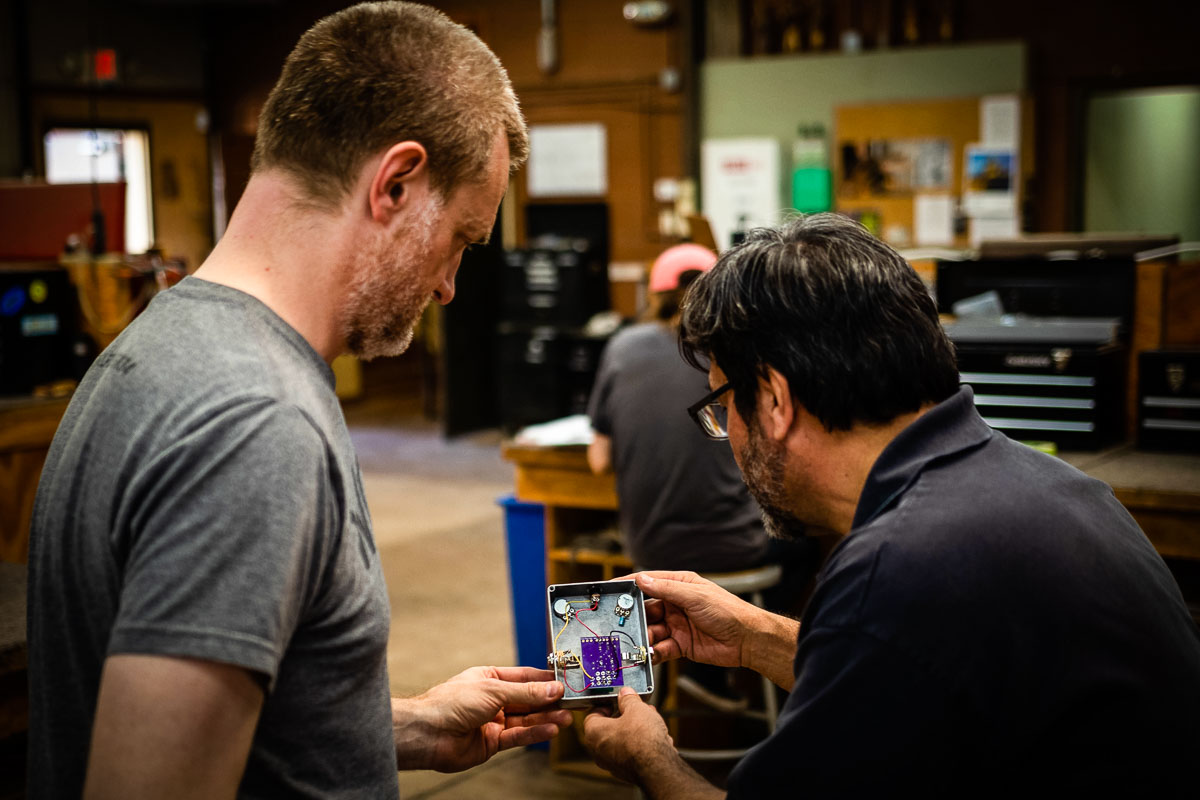
“The vintage sounds we love from pedals come from the mistakes,” Kramer noted, cleaning the soldering iron for the umpteenth time in his quest for distorted perfection. “The Fuzz Face is such a simple circuit, but that also means that if something is off or not quite right, then everything can be affected. The only things that can be wrong are a wrong component, or a wire that’s out of place. Figuring that out, that’s the real education; you don’t want to make those mistakes twice and have to start all over again. That’s where the real learning happens. That’s why what I teach is real electronics: building it is one thing, but understanding it is the real deal.”
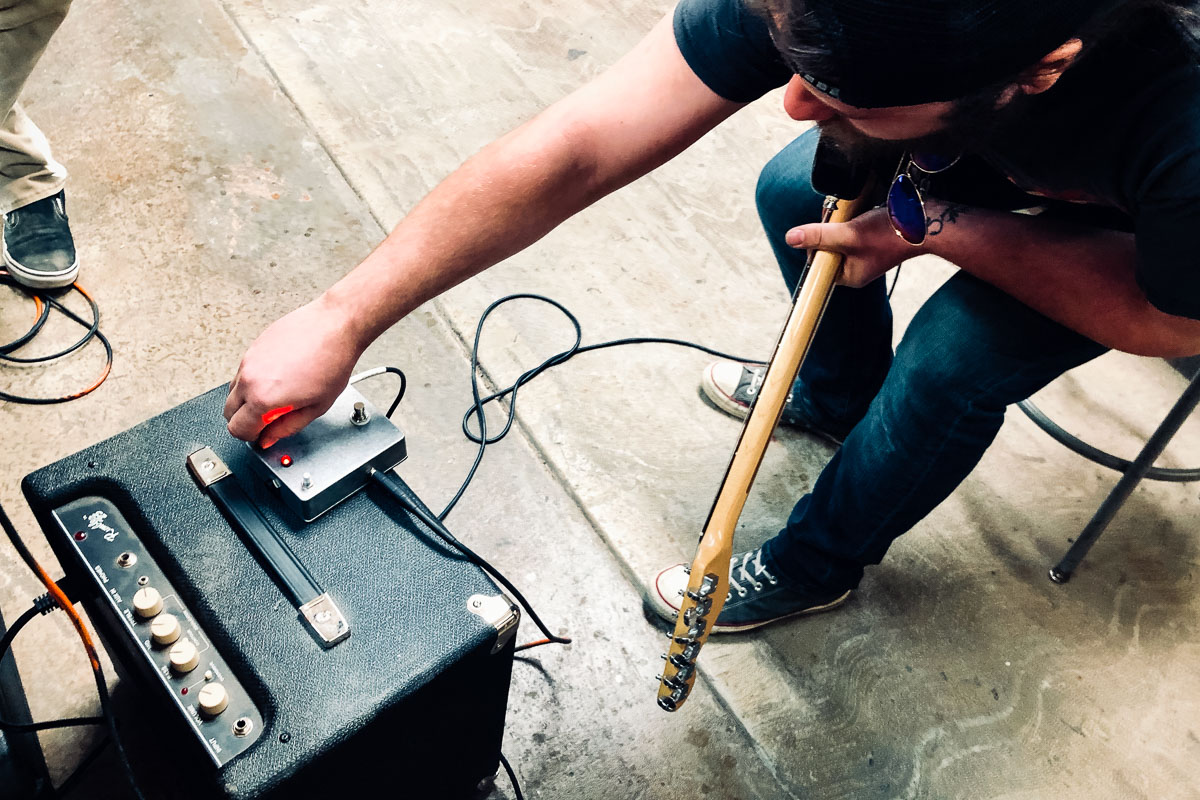
Stompbox Maker Glossary
– Resistor: A passive, two-terminal component that, as part of its design, maintains a specific resistance to electrical current passed through it. The amount of resistance of each individual resistor – “how much heat they will dissipate,” as Kramer put it – is determined via code via its colored bands.
– Capacitor: Often abbreviated as “cap,” a capacitor is a passive device which blocks DC current, but allows AC current to pass through and be stored momentarily before it’s used. “A cap is basically a short-term battery,” Kramer explains. “What really matters is where the capacitor is in the circuit.”
– Transistor: A typically three-terminal semiconductor that serves either as a switch, or as a boost, for a voltage signal. Original Fuzz Face circuits were made of germanium before being switched to more industrially friendly silicon (and the sound changed as a result).
– Bipolar Junction Transistors: A type of semiconductor which Fuzz Faces employ, which is controlled by current. The silicon-based Fuzz Face uses two NPN (negative-positive-negative) bipolar junction transistors in their circuit, which are distinct for their three terminal prongs assigned to an emitter, a base, and a collector. This gives the Fuzz Face its gain/volume boost, a characteristic more of distortion circuits, rather than trad fuzz, which either maintains or creates a slight drop in the guitar’s signal.
– Diode: A device which allows electrical current to flow in one direction, and restricts it in the other.
– PCB Board: PCB stands for “printed-circuit board” – an industrially-produced slab made of non-conductive, heat-resistant material upon which the elements of the circuit are laid out, and ready to be soldered to various connections.
– True Bypass: “The idea of true bypass is simply to route the guitar signal around the effect-generating circuit when the effect is not desired,” Kramer writes in How to Build Your Own Distortion Pedal.
– Enclosure: The box-like case which contains the pedal’s electronics arrangement.

3 Comments
Join the discussion and tell us your opinion.
A detailed article on a very cool subject. Thanks Matt!
Thanks for the nice article, Matt!
[…] of the original Vox CryBaby wah-wah pedal and Matt Diehl’s deep dive into pedal-building with “Stompbox 101: For Real”, drawn from his recent experience at an intensive pedal-building seminar at Phoenix, Arizona’s […]